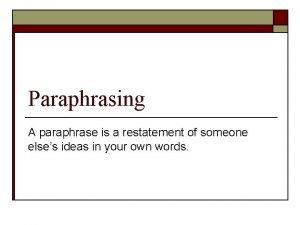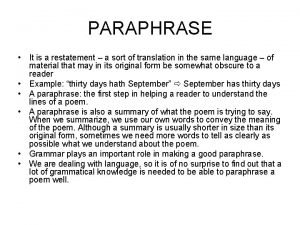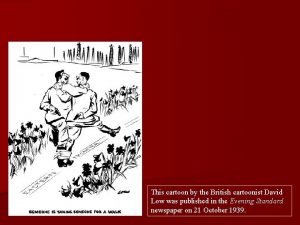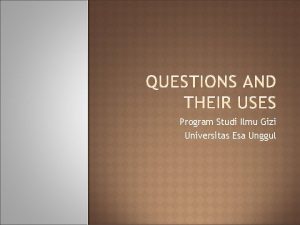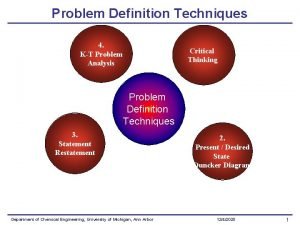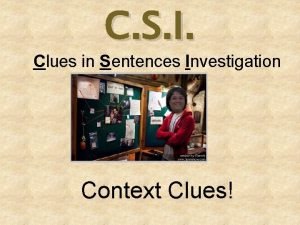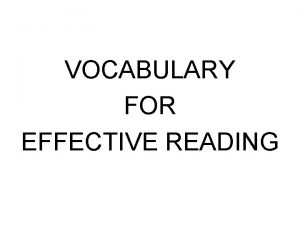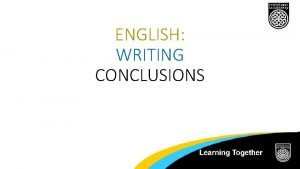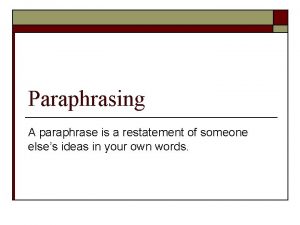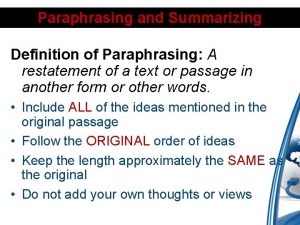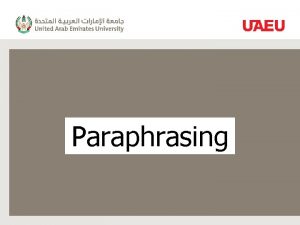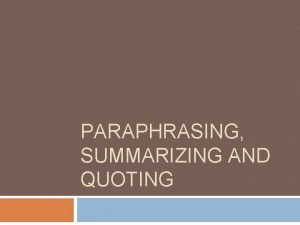Paraphrasing A paraphrase is a restatement of someone









- Slides: 9

Paraphrasing A paraphrase is a restatement of someone else’s ideas in your own words.

Paraphrase vs. Summary o o o A summary restates only the main ideas and a couple of the most important examples. A paraphrase restates all of the supporting details in addition to the main ideas, but in your own words. You should cite your source for both summaries and paraphrases.

Summary Example o The original passage: “Students frequently overuse direct quotation in taking notes, and as a result they overuse quotations in the final [research] paper. Probably only about 10% of your final manuscript should appear as directly quoted matter. Therefore, you should strive to limit the amount of exact transcribing of source materials while taking notes. ” Lester, James D. Writing Research Papers. 2 nd ed. (1976): 46 -47. o An acceptable summary: Students should take just a few notes in direct quotation from sources to help minimize the amount of quoted material in the final research paper (Lester 46 -47).

Paraphrase Example o The original passage: “Students frequently overuse direct quotation in taking notes, and as a result they overuse quotations in the final [research] paper. Probably only about 10% of your final manuscript should appear as directly quoted matter. Therefore, you should strive to limit the amount of exact transcribing of source materials while taking notes. ” Lester, James D. Writing Research Papers. 2 nd ed. (1976): 46 -47. o A legitimate paraphrase: In doing research papers, students often quote too excessively, failing to keep quoted material down to a desirable level of about 10% of the paper. Since the problem usually originates during note taking, it is good to minimize the amount recorded word for word from the source when you are gathering your notes (Lester 46 -47).

Plagiarism Example o The original passage: “Students frequently overuse direct quotation in taking notes, and as a result they overuse quotations in the final [research] paper. Probably only about 10% of your final manuscript should appear as directly quoted matter. Therefore, you should strive to limit the amount of exact transcribing of source materials while taking notes. ” Lester, James D. Writing Research Papers. 2 nd ed. (1976): 46 -47. o A plagiarized version: Students often use too many direct quotations when they take notes, resulting in too many quotes in the final research paper. In fact, only about 10% of the final copy should consist of directly quoted material. So it is important to limit the amount of source material copied while taking notes.

How to Paraphrase 1. 2. 3. Read the text carefully for understanding. Write notes of the main ideas and supporting details. (An outline is helpful for this. ) Next, try to write out sentences expressing these ideas and support in your own words. o o 4. Don’t just change a few words. You should often change the sentence structure when you paraphrase. Use a thesaurus to find synonyms for some words if you get stuck. Check it. Did you restate all the important ideas.

Paraphrase Practice #1 Read the original below and try to write a paraphrase. "At some point in the assimilation to the new way (culture), the immigrant child realizes that his or her parents are no longer sources of real knowledge about the new society. Their information and their way of life are no longer the way to success, and as soon as the child understands this, his or her attitude towards the parents changes. Though some people consider such changes to be a betrayal, they are an inevitable part of assimilation. " (A. Khutorsky, "Immigrants Adapting") -----------------------------------------Immigrant children eventually discover that their parents don’t really know everything about the new culture. When they figure out that their parent’s ideas and way of living aren’t the path to success in the new culture, their relationship with their parents is transformed. This change is a necessary aspect of assimilation, although it may look like disloyalty to some people.

Paraphrase Practice #2 1. 2. 3. 4. 5. 6. Turn to Exercise 11 on page 114. Reread the section “Balancing Effectiveness and Efficiency. ” Page 105 Look at your summary of that section. Look at the synonyms on page 115 for some other choices for words to use. Write your paraphrase. Check your work. Did you express all of the important ideas from the original?

A Paraphrase (Answer for Problem #2): “Balancing Effectiveness & Efficiency” It’s not just word play to emphasize the difference in meaning between effectiveness and efficiency. Recognizing the distinction is important and illustrates a common problem for managers. Effectiveness means quickly achieving your objective. Killing a fly with a sledgehammer, for example, effectively ends your fly problem. But we must face the fact that we have limited resources, so only thinking about effectiveness is not enough. When we consider the resources used to accomplish something against the value of what was accomplished, we are thinking about efficiency.
